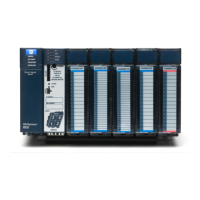
Do you have a question about the GE PACSystems RX7i and is the answer not in the manual?
| Brand | GE |
|---|---|
| Model | PACSystems RX7i |
| Category | Controller |
| Language | English |
Overview of the Proficy Machine Edition (PME) software and PACSystems CPU configuration.
Guidance on upgrading existing Series 90 applications to PACSystems without disturbing panel wiring.
List of manuals and resources for PACSystems products, including support website.
Explains the block-structured application program, _MAIN block, and CPU sweep.
Details the four types of blocks: Block, Parameterized Block, UDFB, and External Block.
Describes %L local data, its scope, and how parameters are passed between blocks.
Overview of Ladder Diagram (LD) language and its logic execution flow.
Defines variables and explains how they are mapped to reference addresses or used symbolically.
Details reference memory areas (%AI, %AQ, %R, %W, %P) and system status references (%S).
Explains numerical data types (INT, REAL, etc.) and User Defined Types (UDTs).
Details functions for math operations (EXP, SQRT, TRIG) and bit manipulation (AND, OR, NOT).
Explains coil types, contact types, and control functions like Do I/O and PID.
Covers type conversion functions and data move operations like Block Move and MOVE_DATA.
Details functions controlling program flow (CALL, JUMPN) and relational comparisons (CMP, EQ, GT).
Covers math (EXPT, SIN, COS) and bit operations (AND, OR, XOR, NOT) in FBD.
Details comparison (EQ, NE, GE), control (Do I/O, PID), and counter functions in FBD.
Explains data move (Fan Out, MOVE) and math functions (ADD, SUB, MUL, DIV) in FBD.
Covers functions for converting data types like WORD to INT, REAL to DINT, and DINT to LREAL in FBD.
Explains how to use the Service Request function in LD and FBD for control system services.
Details using SVC_REQ 7 to read or change the CPU's time-of-day clock using various formats.
Describes using SVC_REQ 13 to stop the CPU after a specified number of scans.
Details using SVC_REQ 20 to retrieve controller or I/O fault tables.
Describes using SVC_REQ 56 to read values from nonvolatile storage.
Details the operands and operation modes (Automatic/Manual) of the PID function.
Explains PID algorithms (PID_IND, PID_ISA) and how to calculate proportional, integral, and derivative gains.
Provides methods for setting PID loop gains (Kp, Ki, Kd) through iterative tuning and Ziegler-Nichols.
Introduces ST language, its statements, expressions, operators, and syntax rules.
Details various ST statement types including Assignment, CASE, IF, FOR...DO, and WHILE.
Covers REPEAT loops, ARG_PRES function, and EXIT statements for controlling program flow.
Explains the fault handling system, fault classes, and system response to various faults.
Guides on displaying and interpreting Controller and I/O Fault Tables using Logic Developer software.
Details system fault references used to identify fault types and their behavior on power-up.
Lists controller fault groups, descriptions, default actions, and corrective measures.
Provides descriptions and corrective actions for various I/O fault categories and types.
Introduces DLBs for diagnosis, explains their operation, and provides examples.